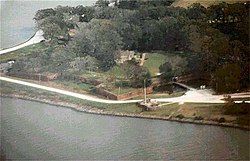Fort Jackson | |
 | |
| Location | Plaquemines Parish, Louisiana, USA |
|---|---|
| Nearest city | Triumph, Louisiana |
| Coordinates | 29°21′25″N 89°27′20″W / 29.3569°N 89.4556°W |
| Built | 1822–32 |
| NRHP reference No. | 66000379 |
| Significant dates | |
| Added to NRHP | October 15, 1966[1] |
| Designated NHL | December 19, 1960 |
Fort Jackson is a historic masonry fort located 40 miles (64 km) up river from the mouth of the Mississippi River in Plaquemines Parish, Louisiana. It was constructed as a coastal defense of New Orleans, between 1822 and 1832, and it was a battle site during the American Civil War.[2] It is a National Historic Landmark. It was damaged by Hurricanes Katrina and Rita, and its condition is threatened. It is marked Battery Millar on some maps,[3] for the Endicott era work built nearby it.



Fort Jackson is situated approximately 70 miles (110 km) south of New Orleans on the western bank of the Mississippi, approximately 2.5 miles (4.0 km) south of Triumph, Louisiana. The older Fort St. Philip is located opposite of Fort Jackson on the eastern bank; this West Bank fort was constructed after the War of 1812 on the advice of Andrew Jackson, for whom it is named.
The fort was occupied off and on for various military purposes from its completion until after World War I, when it served as a training station. It is now a National Historic Landmark and historical museum owned and operated by Plaquemines Parish.
Fort Jackson was the site of the Battle of Forts Jackson and St. Philip from April 16 to April 28, 1862, during the American Civil War. The Confederate-controlled fort was besieged for 12 days by the fleet of U.S. Navy Flag Officer David Farragut. Fort Jackson fell on April 28 after the Union fleet bombarded it and then sailed past its guns. A mutiny against the officers and conditions then occurred and the fort fell to the Union. Union forces then went on to capture New Orleans.[5]
Following the engagement, Fort Jackson was used as a Union prison. It was here that the French champagne magnate Charles Heidsieck was held for seven months on charges of spying.
- ^ "National Register Information System". National Register of Historic Places. National Park Service. January 23, 2007.
- ^ StoppingPoints.com. "Text of Fort Jackson historical marker".
- ^ "Google Maps".
- ^ ORN I, v. 18, p.373.
- ^ North & South, Volume 11, Number 2, Page 18, accessed April 16, 2010, "Mutiny at Fort Jackson" Archived July 14, 2011, at the Wayback Machine

